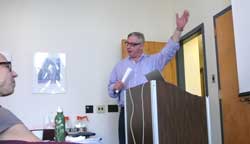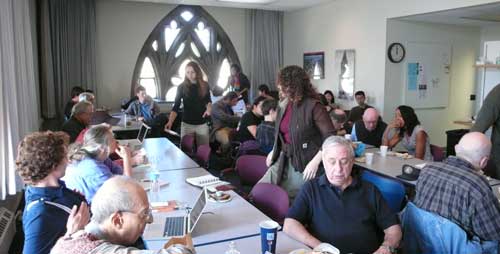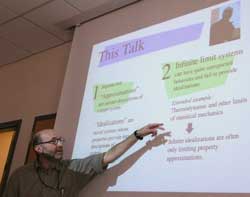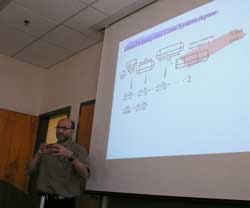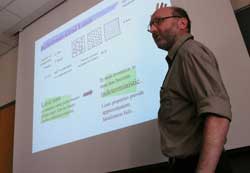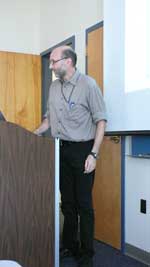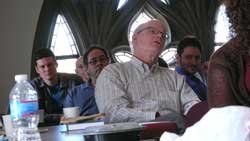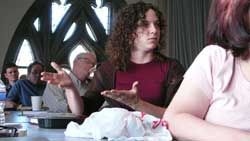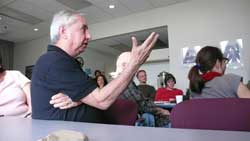

![]()
home
::: about
::: news
::: links
::: giving
::: contact
![]()
events
::: calendar
::: lunchtime
::: annual
lecture series
::: conferences
![]()
people
::: visiting fellows
::: postdoc fellows
::: resident fellows
::: associates
![]()
joining
::: visiting fellowships
::: postdoc fellowships
::: senior fellowships
::: resident fellowships
::: associateships
![]()
being here
::: visiting
::: the last donut
::: photo album
|
The last bagel
What makes the experience just a little more uncomfortable is that the person is Peter Machamer. As he spoke, for some reason an old saw was sticking in my head. "He was a bold man that first ate an oyster," wrote Jonathan Swift. His words had now transformed in my head into "It is bold man who has Peter Machamer introduce him." It is too late now. The menu is selected and the service is underway. In the event, the repast was not so bad. Peter smiled and offered to summarize my work. He proceeded through a list of intentional misdescriptions, carefully tuned to be both funny and just not quite provocative enough to require response. When it was over, I rose and thanked him, noting that it could have been much worse. There was a titter amongst those sitting nearby.
That has long seemed strange to me, if not even a little bizarre. The atomic theory of matter is based on the idea that there are only finitely many components--molecules, atoms, spins--in an ordinary thermal system. If our theory can only give us familiar thermal properties by analyzing systems of infinitely many components, then the atomic theory is refuted. The size of atoms and the finiteness of their number in a melting ice cube is not negotiable. If the ice cube must have infinitely many molecules to be able to melt, atomic theory is done. Cooked. Dead. Poor Boltzmann--defeated at last.
Some of that talk, I suspected, was purposefully provocative. It asserts things that, read literally, are false, but exciting. Behind it was a second, non-literal reading that respected Boltzmann, but was just banal. In the end, very little of the literature turned out to examine the properties of systems that consist of an actual infinity of components.
How did this literature achieve its results? Most of them turn out to come from finding the behavior of very large, but still finite systems. If an infinite limit is taken, it is only after these properties have been determined. Then an "n" in a formulae describing them is let go to infinity. What results is typically not a property of the system with an actual infinity of components. But the result does serve to approximate the large system quite well.
"Approximation and Idealization: Why the Difference Matters" That is just a part of the story. There's lots more in the paper. What can I say? All those details are precious and too precious to leave out of the story. So even though I had trimmed down the Powerpoints, I still had too much in the talk. I knew this, so I knew I had to keep moving. I did. In fact I moved too fast and finished the talk in 35 minutes, which is at the short end for our lunchtime talks. The resulting gallop was probably too fast for someone innocent of the details. It was over. Peter Machamer called for our usual break. "There are some donuts left, but there are no bagels." This is a good thing, I thought. It means that we had a good turn out for the talk, or at least more than we expected. But then the real test is whether this turn out returns for my next talk! We now turned to question time. All speakers have the illusion that they spoke perfectly clearly, so that there could be no confusions. And every speaker has the little vanity that the view presented is so well worked out and so perfectly crafted that dispute is impossible. A good tonic for those illusions is to have audience members who see things in quite the opposite way to you. For them, it is just as clear that you are wrong and and that your carefully crafted formulations are merely clever sophistry, a deception preying on the unwary. For them, all that needs to be found in question time is the right combination of words that will reveal your errors succinctly. Several questions were quite friendly and, afterwards, private discussions were encouraging. But there was enough tonic in the room to make question time rather more tense than I like. Peter Machamer cut off discussion more than once, if I recall correctly, with a growl that this discussion was not advancing. I'm entering unresolved debates in the present literature. What was I expecting? Trumpets, elephants, and laurel wreaths?! At least someone could have left me a bagel. John D. Norton |
